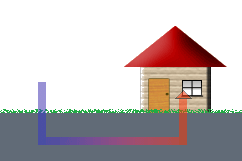 GAEA: Demo version
GAEA: Demo version

Earth heat exchangers (EHX) can reduce the energy demand of a building. During winter time they preheat air for the ventilation of the building. In summer time they help to avoid overheating inside the building. In both cases, EHX contribute to increase the comfort of living with simple measures and low costs. In spite of the simple structure of EHX, their behaviour concerning temperature and heat gains is difficult to determine with satisfactory precision.
GAEA is an easy-to-use program which supports the layout of EHX in the early stage of the planning of a building. It is based on analytic calculations of heat exchange between soil, systems of parallel buried pipes and the air flow through the system. The heat exchange for the air flowing through the EHX and the corresponding change of temperature is calculated together with a lot of other data following from that. The yearly variation of the soil temperature is taken into account, as well as the influence of nearby buildings or of the groundwater level, the fluctuation of the ventilation flow according to the occurring ventilation loads, and the course of outdoor temperature according to typical climatic data or measurements. An optimisation routine presents a choice of possible variations of the layout and their assessment concerning heat gains and economics.
With the help of the quick calculation method of GAEA, a lot of variations of EHX systems can be analysed in a short time to reach the best possible layout. Additionally, GAEA enables the presentation of the mode of operating of EHX. Thereby, it can help in teaching and further education to increase the knowledge about these useful building devices and contribute to their dissemination.
GAEA is available for you as a free demo version (in English) in the WWW. The demo-version is fully operational, but limited in the time you can test it (10 days).